One of my favorite 17th-century artists is Johannes Vermeer. He has painted so many brilliant works of art that every artist should appreciate.
Johannes Vermeer, a Dutch painter of the 17th century, is revered as one of the greatest masters of the Dutch Golden Age. His works are renowned for their exquisite detail, masterful use of light and shadow, and ability to capture intimate moments of daily life. Despite a relatively small output, Vermeer’s paintings have left an indelible mark on the art world.
Table of Contents
- Johannes Vermeer: A Visionary 17th Century Dutch Artist
- Top 10 Paintings Of Johannes Vermeer
- “Girl with a Pearl Earring” (c. 1665) by Johannes Vermeer
- “The Milkmaid” (c. 1657-1661) by Johannes Vermeer
- “View of Delft” (c. 1660-1661) by Johannes Vermeer
- “The Art of Painting” (c. 1666-1668) by Johannes Vermeer
- “The Concert” (c. 1664) by Johannes Vermeer
- “Woman Holding a Balance” (c. 1662-1663) by Johannes Vermeer
- “The Astronomer” (c. 1668) by Johannes Vermeer
- “The Geographer” (c. 1668-1669) by Johannes Vermeer
- “The Girl with the Wine Glass” (c. 1659-1660) by Johannes Vermeer
- “The Lacemaker” (c. 1669-1670) by Johannes Vermeer
- Watch Our Short Stories About Top 10 Johannes Vermeer Paintings Below!
- Frequently Asked Questions
- Related Questions
Johannes Vermeer: A Visionary 17th Century Dutch Artist

Johannes Vermeer was born in Delft, the Netherlands, in 1632. He lived and worked in relative obscurity during his lifetime, and it was not until the 19th century that his art gained recognition and acclaim.
Vermeer’s significance lies in his ability to create paintings that transcend mere visual representation and offer glimpses into the nuanced complexities of human experience; Johannes Vermeer’s meticulous attention to detail, great use of color, and mastery of light and shadow set him apart from his contemporaries.
His paintings often portray domestic scenes, genre paintings, and portraits. Vermeer’s compositions are characterized by harmony and balance, with carefully arranged figures and objects that invite viewers into intimate narratives.
The Rarity Of Vermeer’s Surviving Works
One of the intriguing aspects of Vermeer’s legacy is the scarcity of his surviving paintings. It is estimated that he created approximately 60 paintings throughout his career, but only about 36 have been attributed to him with certainty. This scarcity adds to the allure and mystique surrounding Vermeer’s art.
The reasons for the limited number of Vermeer’s paintings are unclear. It is possible that Vermeer’s slow and meticulous working process and meticulous attention to detail contributed to the relatively low number of completed works. Moreover, his paintings were not widely circulated or known beyond his immediate circle during his lifetime, which may have contributed to their rarity.
Top 10 Paintings Of Johannes Vermeer
Even with the limited amount of Johanne Vermeer paintings, many of his surviving works of art are considered masterpieces. Below are ten of our top Johannes Vermeer paintings and why we consider them significant.
“Girl with a Pearl Earring” (c. 1665) by Johannes Vermeer
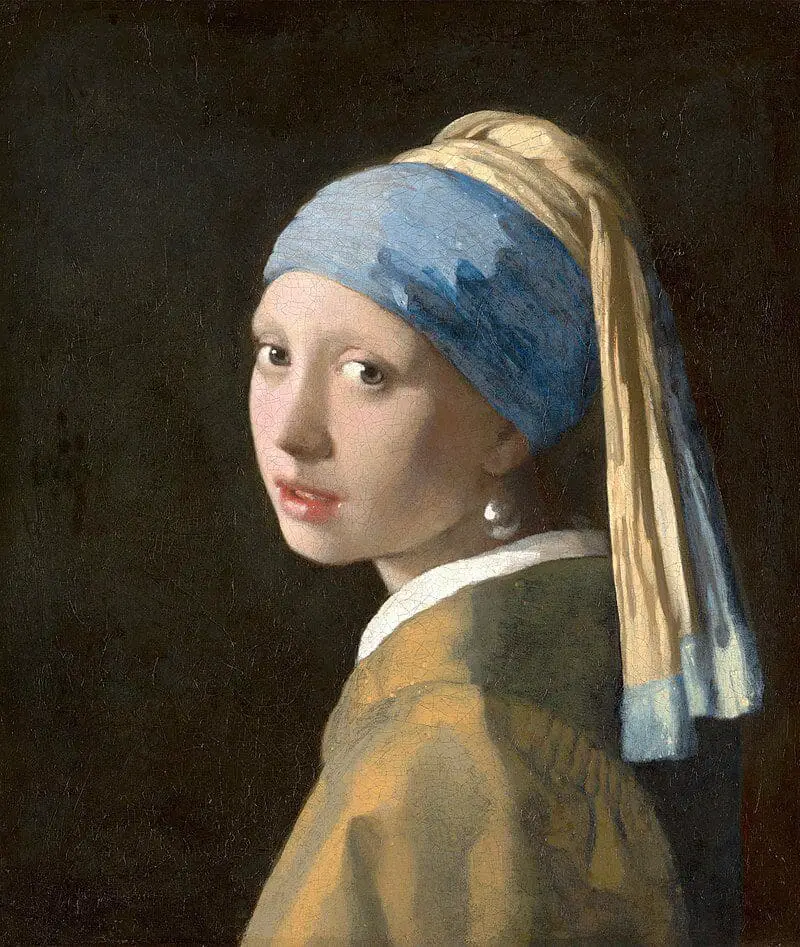
Considered one of Vermeer’s most iconic works, the Girl With A Pearl Earring portrait depicts a young woman with a captivating gaze. The mysterious subject, rich color palette, and luminous rendering of the pearl earring make this painting a masterpiece of Dutch portraiture.
“The Milkmaid” (c. 1657-1661) by Johannes Vermeer
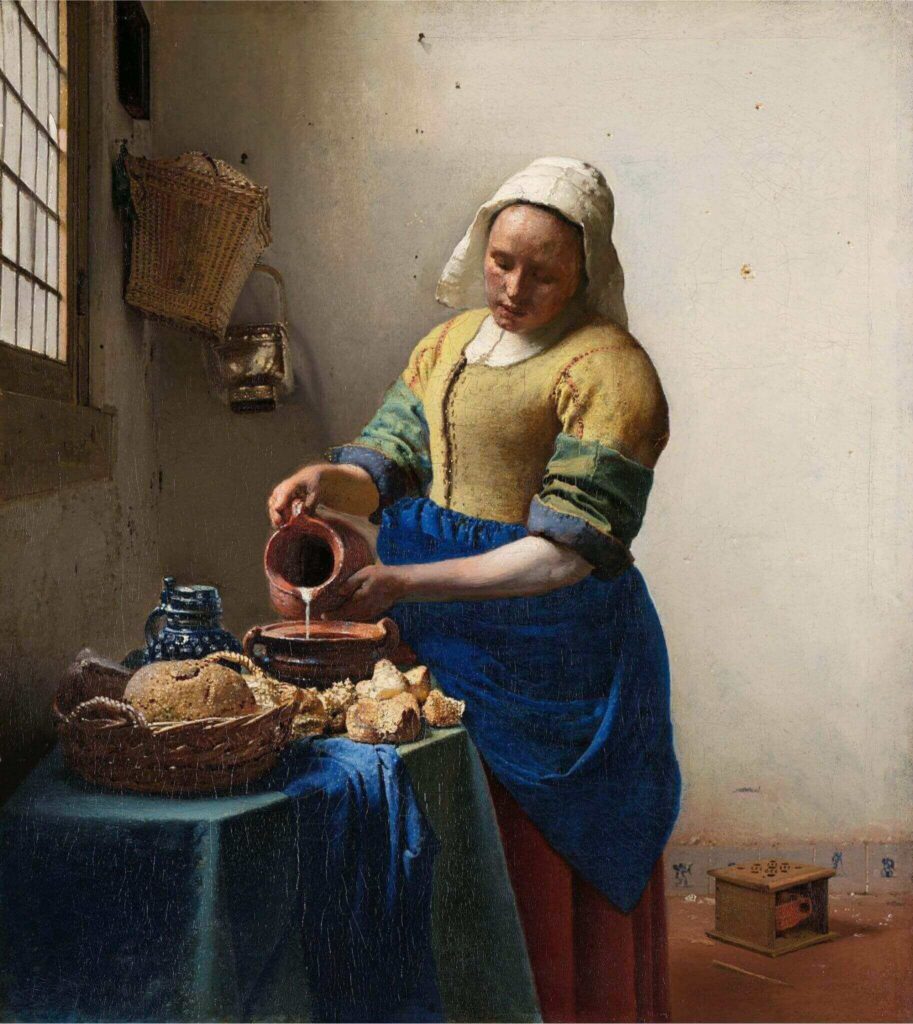
This Milkmaid painting portrays a domestic servant pouring milk, capturing a quiet moment of everyday life. Vermeer’s attention to light, texture, and meticulous detail elevates the scene to a sublime level, highlighting his ability to infuse ordinary moments with extraordinary beauty.
“View of Delft” (c. 1660-1661) by Johannes Vermeer
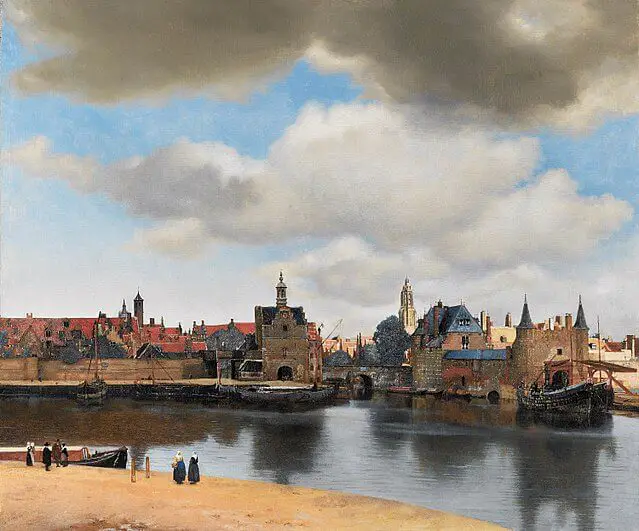
This cityscape of View of Delft is one of Vermeer’s few known landscapes. It showcases his virtuosity in capturing architectural details, atmospheric effects, and the play of light on the water. The painting exemplifies Vermeer’s ability to convey a sense of stillness and tranquility in his compositions.
“The Art of Painting” (c. 1666-1668) by Johannes Vermeer
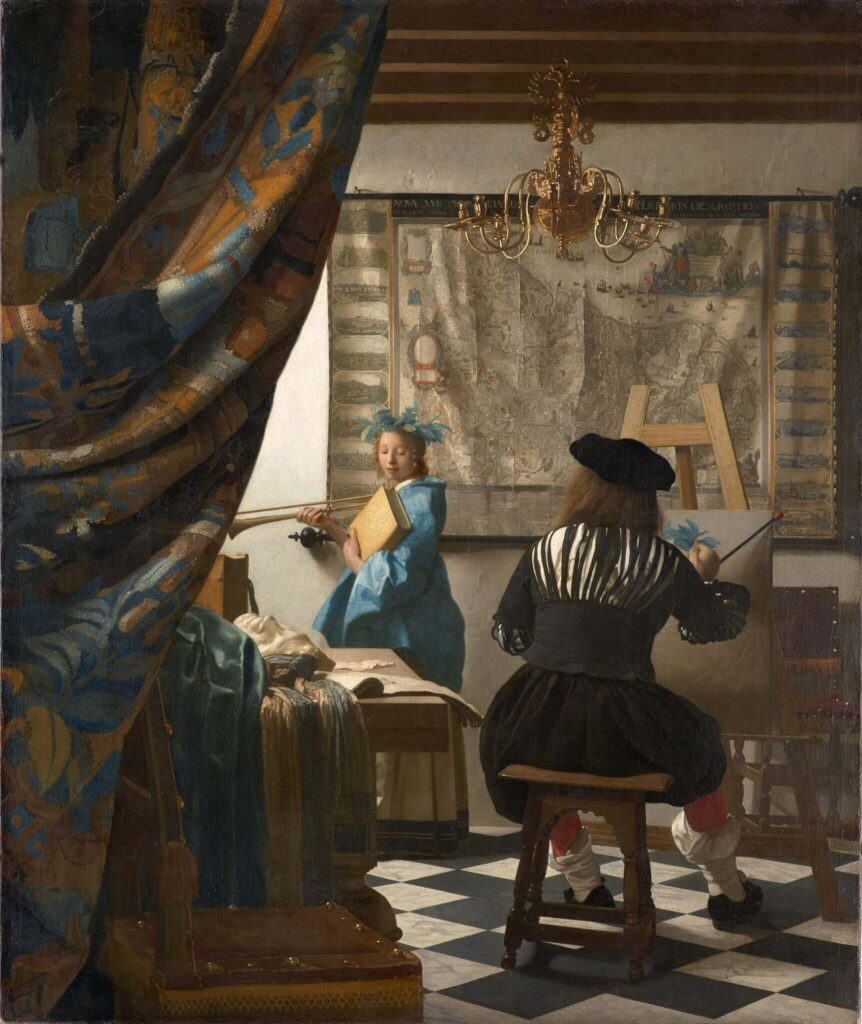
This allegorical work of The Art of Painting depicts a painter in his studio, surrounded by symbolic elements that allude to the power and significance of art. Vermeer’s mastery of light, intricate details, and compositional complexity make this painting a testament to his artistic prowess and intellectual depth.
“The Concert” (c. 1664) by Johannes Vermeer
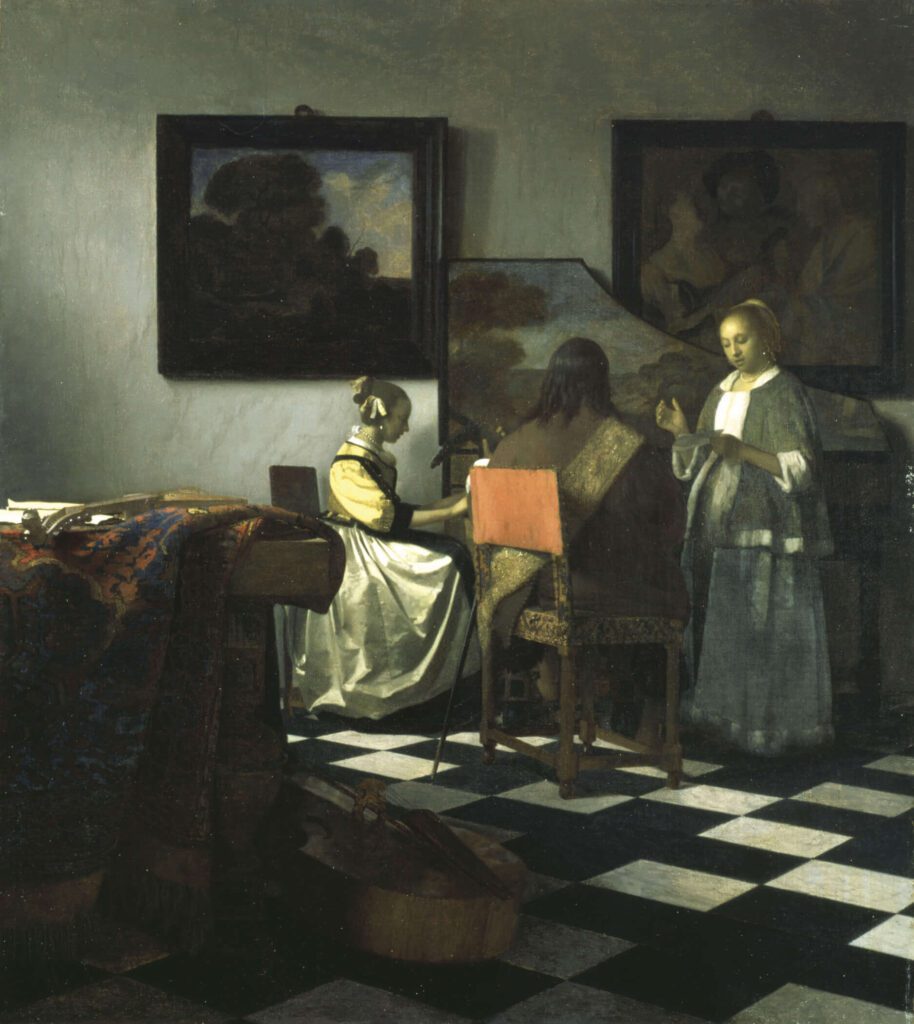
Regrettably, “The Concert” is one of Vermeer’s lost works. It was stolen in 1990 from the Isabella Stewart Gardner Museum in Boston and remains unrecovered. The painting is celebrated for depicting three figures engaged in music-making, showcasing Vermeer’s ability to capture a sense of harmony and serenity.
“Woman Holding a Balance” (c. 1662-1663) by Johannes Vermeer
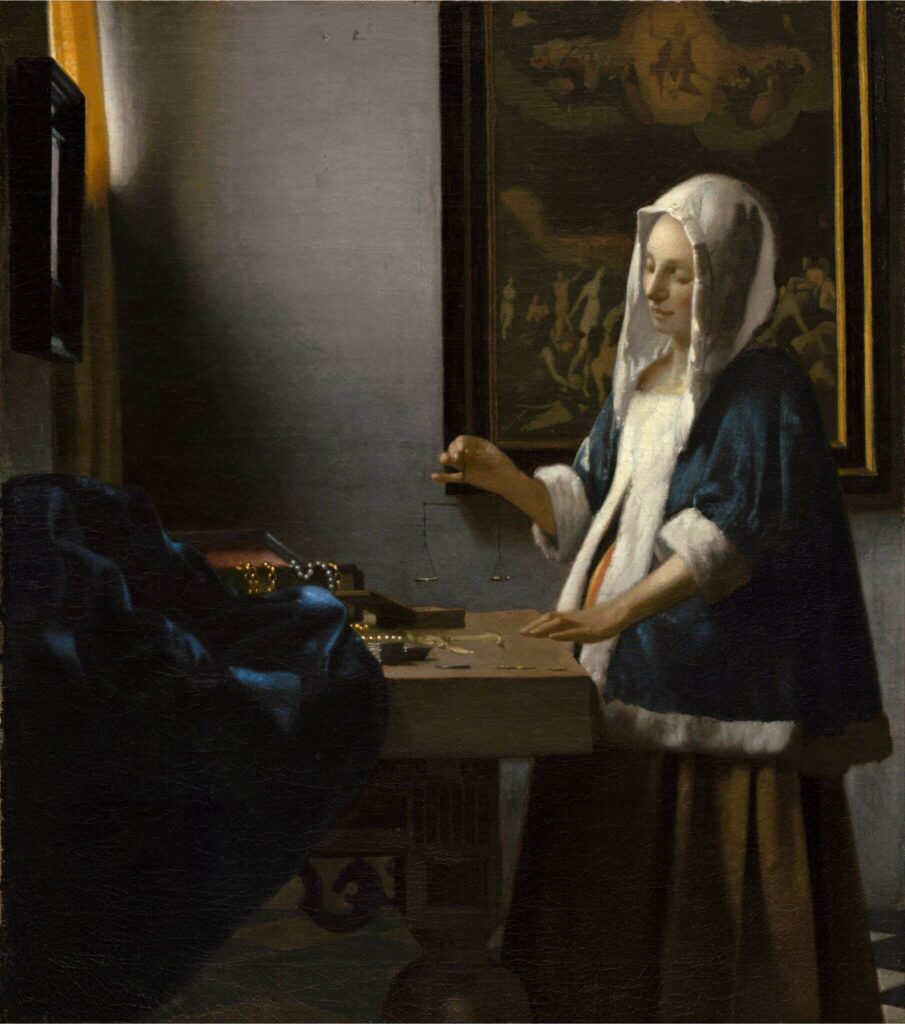
This contemplative painting depicts a woman weighing gold coins on balance. It symbolizes the transient nature of wealth and the eternal value of spiritual pursuits. Vermeer’s meticulous attention to light, texture, and symbolic details renders this work visually stunning and intellectually engaging.
“The Astronomer” (c. 1668) by Johannes Vermeer
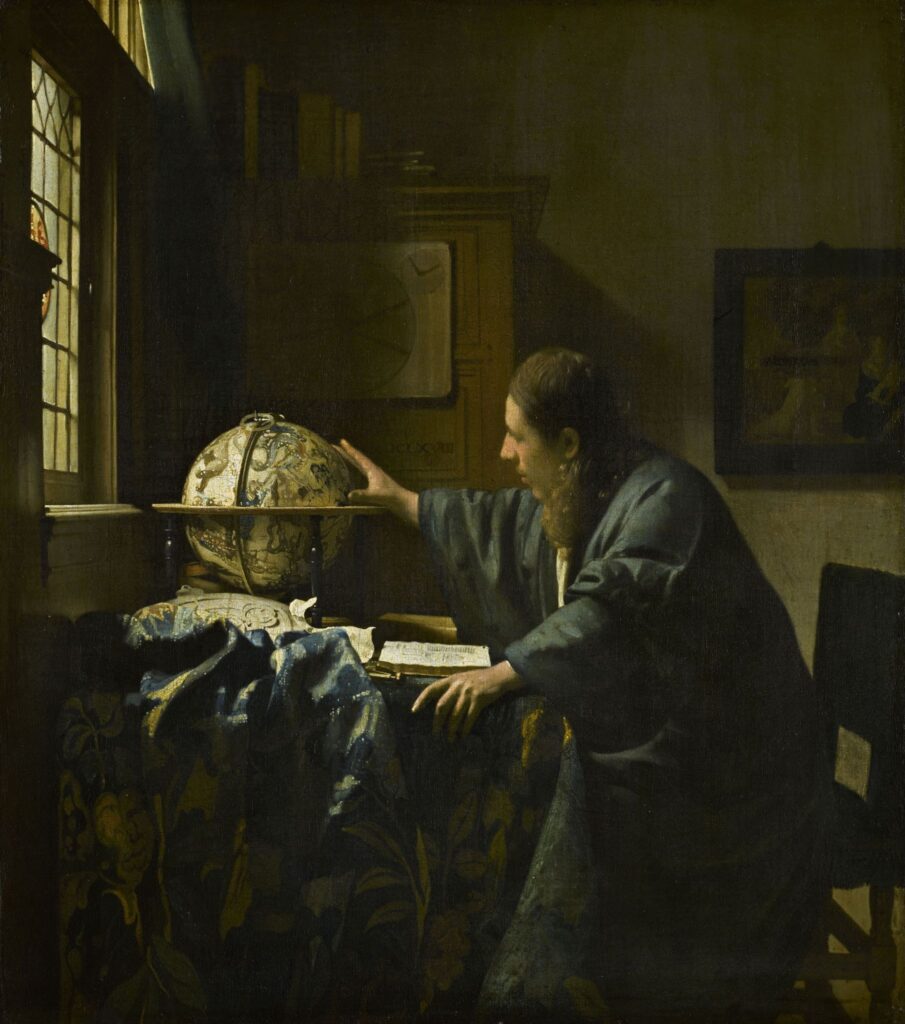
In this scientific-themed painting, Vermeer portrays a scholar studying the heavens. The meticulous rendering of the astronomer’s instruments and the play of light on his face showcase Vermeer’s skill in capturing both the material and immaterial realms.
“The Geographer” (c. 1668-1669) by Johannes Vermeer
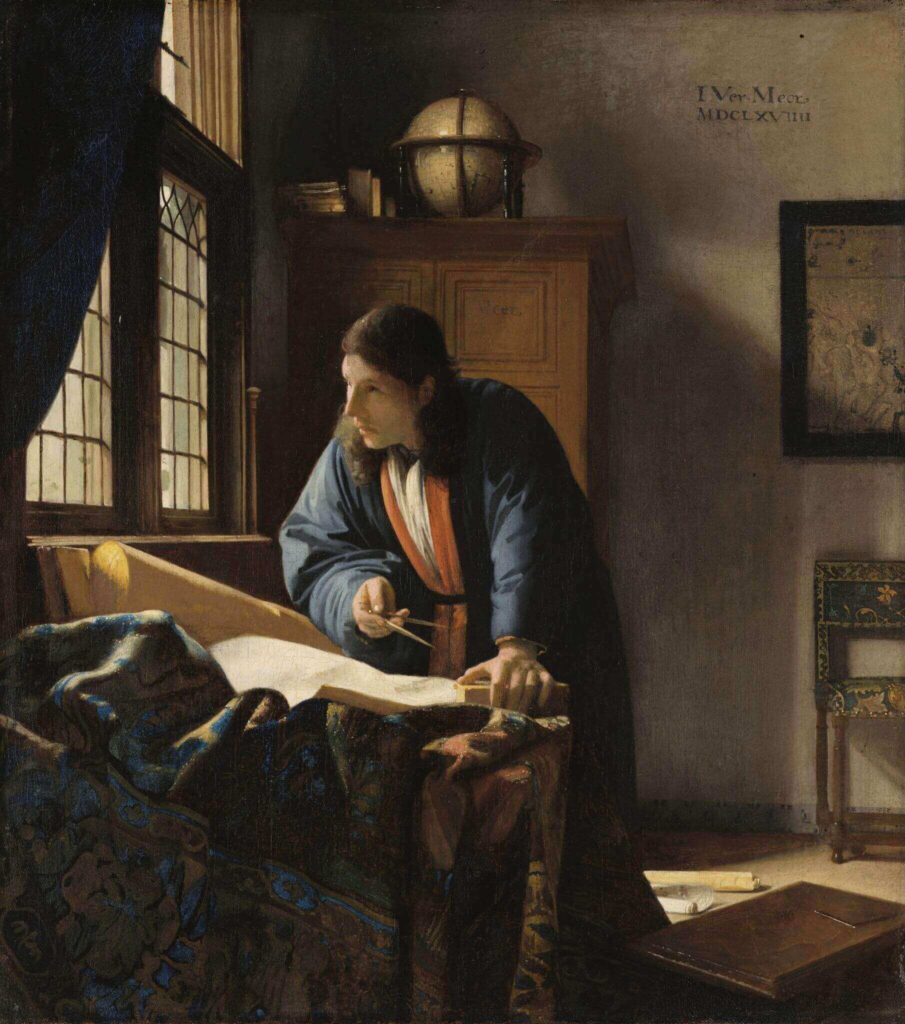
Like “The Astronomer,” this painting depicts a scholar immersed in his work. Vermeer’s attention to detail and use of light contribute to the atmosphere of intellectual exploration and introspection.
“The Girl with the Wine Glass” (c. 1659-1660) by Johannes Vermeer
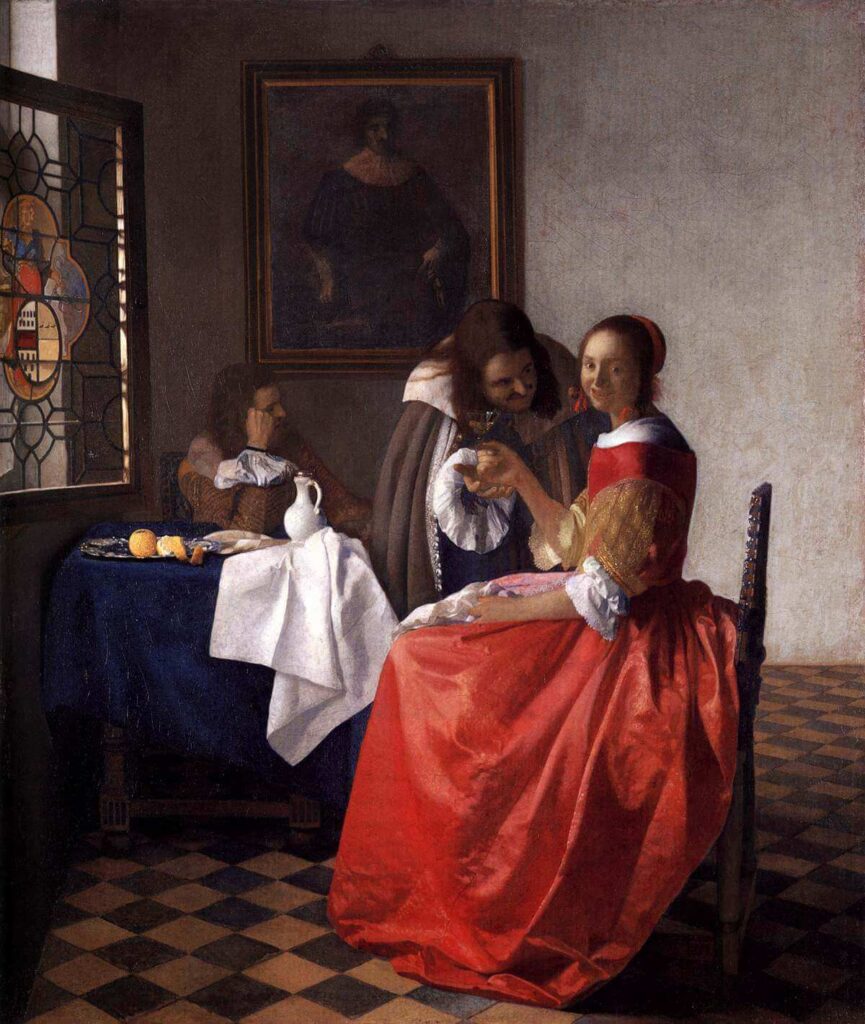
This lively genre scene captures a young woman holding a glass of wine, engaging the viewer with her direct gaze. Vermeer’s skillful handling of light, the vibrant color palette, and the rendering of textures contribute to the painting’s captivating charm.
“The Lacemaker” (c. 1669-1670) by Johannes Vermeer
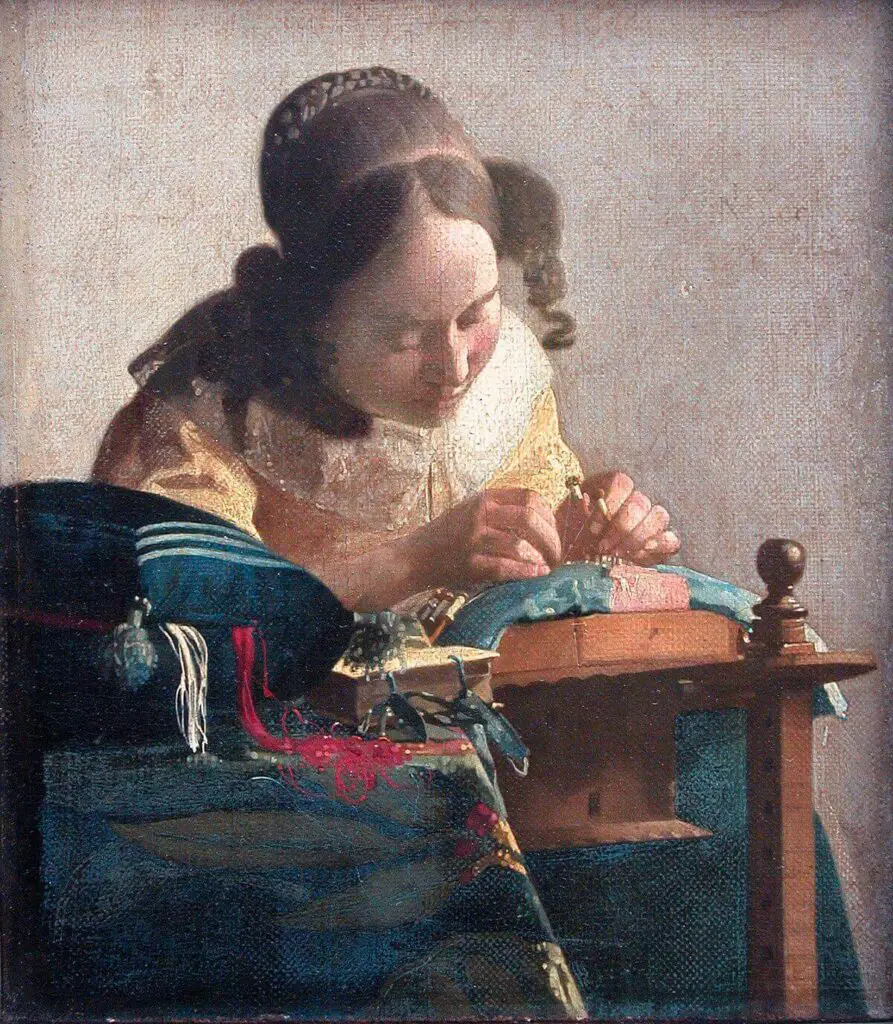
This intimate and tender portrayal of a young woman engrossed in lacemaking showcases Vermeer’s ability to capture delicate textures and nuanced expressions. The meticulous attention to detail in the lacework exemplifies Vermeer’s unrivaled technical proficiency.
Johannes Vermeer’s surviving artwork is relatively small but immensely influential. His mastery of light, attention to detail, and ability to elevate everyday scenes to sublime moments make his paintings timeless and captivating.
Despite the scarcity of surviving works, Vermeer’s artistic genius continues to captivate art enthusiasts and inspire generations of artists.
The top ten paintings mentioned, including “Girl with a Pearl Earring,” “The Milkmaid,” “View of Delft,” “The Art of Painting,” and others, showcase Vermeer’s exceptional talent and his ability to create poetic and introspective compositions. Each painting offers a glimpse into Vermeer’s profound understanding of light, composition, and the human condition.
Vermeer’s legacy as a significant artist lies in his ability to transcend the ordinary and reveal the extraordinary within the mundane. His works remain timeless examples of the power of art to transcend time, touch the human soul, and evoke emotions that resonate across centuries.
Watch Our Short Stories About Top 10 Johannes Vermeer Paintings Below!
Anita Louise Art is dedicated to art education, great artists, and inspiring others to find and create their art. We love art that uplifts and inspires. #ArtToMakeYouSmile! #ArtToMakeYouHappy!
If you are interested to see any of my art, you can find out more by clicking here. If you are interested in what inspires me and my paintings, you can discover more by clicking here.
We have a free newsletter and would love you to be part of our community; you can subscribe to the newsletter by clicking here. If you have any questions, I would be happy to talk to you. You can reach me, Anita, by clicking here.
Subscribe to our Anita Louise Art YouTube Channel filled with great videos and information by clicking here.
Join us for our podcast “5 Minutes With Art.” Spend just 5 minutes a week with us to discover and learn about great art and artists. You can find out more about our podcast by clicking here.
Frequently Asked Questions
Who was Johannes Vermeer?
Johannes Vermeer was a Dutch painter who lived during the 17th century and is considered one of the greatest masters of the Dutch Golden Age.
When was Vermeer born and when did he die?
Vermeer was born on October 31, 1632, in Delft, Netherlands, and he died on December 15, 1675, in the same city.
What is Vermeer’s most famous painting?
Vermeer’s most famous painting is arguably “Girl with a Pearl Earring,” which is renowned for its enigmatic subject and captivating use of light.
How many paintings did Vermeer create?
Vermeer’s oeuvre is relatively small compared to other artists of his time. It is believed that he created around 34 to 36 paintings during his lifetime.
What are the distinctive characteristics of Vermeer’s paintings?
Vermeer’s paintings are characterized by their meticulous attention to detail, masterful use of light and shadow, and the depiction of domestic interiors and everyday scenes.
Did Vermeer achieve fame during his lifetime?
Vermeer did not achieve significant fame during his lifetime, and his work was primarily appreciated by a small circle of patrons and collectors in Delft.
Why is Vermeer considered a master of the Dutch Golden Age?
Vermeer is regarded as a master of the Dutch Golden Age due to his exceptional skill in capturing the subtleties of light and his ability to create a sense of quiet intimacy in his paintings.
How did Vermeer’s paintings influence other artists?
Vermeer’s paintings had a profound influence on subsequent artists, particularly in the realms of light, composition, and the use of color. His work inspired later painters, including the Impressionists.
Related Questions
Is Art An Natural Gift, Or Can Anyone Be Good At Art If They Practice?
Most artists have some natural gift or desire to be an artist. But their education, hard work, practice, and association with other artists make all the difference. Having a natural gift is the start of becoming an artist, but just having a natural gift will not make you a good artist. Becoming a great artist requires practice, education, and hard work.
By clicking here, you can learn more by reading Is Art An Natural Gift, Or Can Anyone Be Good At Art If They Practice?.
Artemisia Gentileschi And Breaking Gender Barriers In Art
In the 17th Century in Italy, women had two career choices: joining a convent and becoming a nun or wife and mother. The laws also dictated that the man in the women’s lives, such as their fathers, husbands, and even sons, would make all the decisions for their lives. Women during this time had very few rights.
By clicking here, you can learn more by reading Artemisia Gentileschi And Breaking Gender Barriers In Art.
What Is The Difference Between Unity And Harmony in Arts?
Harmony is about art that creates cohesiveness; it stresses the similarities but related parts in the work of art. Unity is a much broader term; unity is all about the different parts of the work of art that are separate, but all work together as one. In other words, unity is all the parts working well together in art.
By clicking here, you can learn more by reading What Is The Difference Between Unity And Harmony in Arts?.

